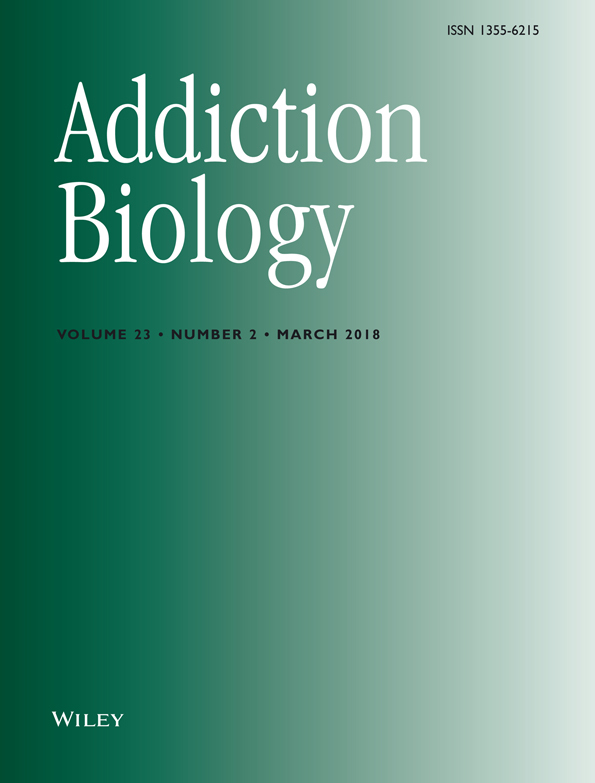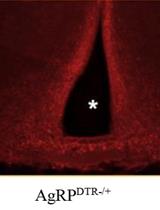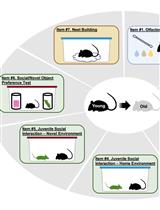- EN - English
- CN - 中文
Protocol for Measuring Compulsive-like Feeding Behavior in Mice
小鼠强迫性进食行为的检测步骤
(*contributed equally to this work) 发布: 2019年07月20日第9卷第14期 DOI: 10.21769/BioProtoc.3308 浏览次数: 5971
评审: Arnau Busquets-GarciaYann HeraultMadeline Keleher

相关实验方案
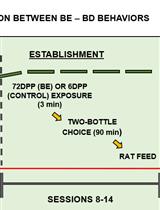
从食物到酒精的狂饮:雄性Wistar大鼠嗜酒行为之间的顺序相互作用
Sergio Cuesta-Martínez [...] Cruz Miguel Cendán
2023年08月05日 1325 阅读
Abstract
Obesity is an important health problem with a strong environmental component that is acquiring pandemic proportion. The high availability of caloric dense foods promotes overeating potentially causing obesity. Animal models are key to validate novel therapeutic strategies, but researchers must carefully select the appropriate model to draw the right conclusions. Obesity is defined by an increased body mass index greater than 30 and characterized by an excess of adipose tissue. However, the regulation of food intake involves a close interrelationship between homeostatic and non-homeostatic factors. Studies in animal models have shown that intermittent access to sweetened or calorie-dense foods induces changes in feeding behavior. However, these studies are focused mainly on the final outcome (obesity) rather than on the primary dysfunction underlying the overeating of palatable foods. We describe a protocol to study overeating in mice using diet-induced obesity (DIO). This method can be applied to free choice between palatable food and a standard rodent chow or to forced intake of calorie-dense and/or palatable diets. Exposure to such diets is sufficient to promote changes in meal pattern that we register and analyze during the period of weight gain allowing the longitudinal characterization of feeding behavior in mice. Abnormal eating behaviors such as binge eating or snacking, behavioral alterations commonly observed in obese humans, can be detected using our protocol. In the free-choice procedure, mice develop a preference for the rewarding palatable food showing the reinforcing effect of this diet. Compulsive components of feeding are reflected by maintenance of feeding despite an adverse bitter taste caused by adulteration with quinine and by the negligence of standard chow when access to palatable food is ceased or temporally limited. Our strategy also enables to identify compulsive overeating in mice under a high-caloric regime by using limited food access and finally, we propose complementary behavioral tests to confirm the non-homeostatic food-taking triggered by these foods. Finally, we describe how to computationally explore large longitudinal behavioral datasets.
Keywords: Compulsive overeating (强迫性进食行为)Background
Research in rodents and humans has shown that exposure to food rich in sweets and fats increases the risk for obesity and compulsive eating behavior (Avena et al., 2009). Exposure to such diets induces meal-pattern changes on patients defined by large meal size of dense caloric foods, rapid food consumption and loss of self-control during the eating episodes. Nevertheless, the development of such feeding behavior disturbances has not been studied, and intermediate states when changes in behavioral output occur remain obscure. These periods are particularly interesting because during weight gain, individuals may shift from non-pathological food consumption to compulsive overeating. In fact, short-term laboratory-based measures of eating in weight stable obese individuals may not be functionally relevant to understand long-term changes in body weight gain.
To address this, we used longitudinal meal pattern analysis for the study of obesity development (Espinosa-Carrasco et al., 2018a). Here, we describe a diet-induced obesity protocol based on ad libitum access to high-fat and chocolate diets. The protocol combines continuous recording of mouse feeding behavior and the use of specific standalone behavioral tests. This longitudinal analysis allows researchers registering and analyzing the time-dependent appearance and evolution of behavioral and cognitive changes upon body weight increase. Water consumption is also measured since it is strongly linked to food intake and for example declines dramatically in fasted or food-restricted animals (Ellacott et al., 2010; Goltstein et al., 2018). Additional tests measure the preference for rewarding stimuli (e.g., voluntary sucrose intake: Towell et al., 1987) and help quantify the perception of reward (‘liking’), whereas reward seeking (‘wanting’) is reflected by the intervals between feeding bouts. Inflexibility is a key indicator of compulsive feeding and can be assessed by temporally limiting the access to palatable food. A flexible response would result in a change to still available standard chow, whereas inflexibility would be revealed by neglect of the alternative (standard chow again). Other ways to search for compulsive components are to create a conflict by adulterating palatable food with bitter-tasting quinine (Heyne et al., 2009; Di Segni et al., 2014). The selected battery of tests, combined with the longitudinal food intake and motor activity recordings, enables i) a more comprehensive and in-depth characterization of the behavioral changes upon free access to palatable diets, ii) the examination of the etiological and susceptibility genetic factors and iii) the exploration of the basic mechanisms underlying compulsive overeating.
Materials and Reagents
- Mice
Adult (12 weeks of age or older) male mice (C57BL/6J) (Charles River, L’Arbresle, France, Strain Code 027), weighing 22-28 g at the beginning of the experiments. Mice are housed individually, each in their respective cages, in an environment with controlled temperature (around 23 °C) and humidity under a 12-12 h light-dark cycle with free access to food. Young adult mice (> 12 weeks) are used to avoid a bias due to the increase of body weight of the developmental growth curve.
Note: C57BL/6J mouse is chosen because it is widely used as a model for diet induced obesity since it is prone to develop severe obesity, elevated adiposity, glucose intolerance and moderate insulin resistance. However, other strains and ages of mice may also be used, but taking into account that strains such as SWR/J and A/J mice are more resistant to obesity development. The weight at the beginning of the experiments is just an indication (mean weight of C57BL/6J 12-weeks mouse). Of note, the initial weight of the animals could differ if a different strain is used. - Diet
In the diet-induced obesity protocol, animals can be allocated to receive free access of chocolate-mixture (CM) or exclusive access of high-fat diet (HF) for the study of obesity development as shown in Figure 1A. From now on, CM experiment is referred to as condition 1 and HF experiment as condition 2.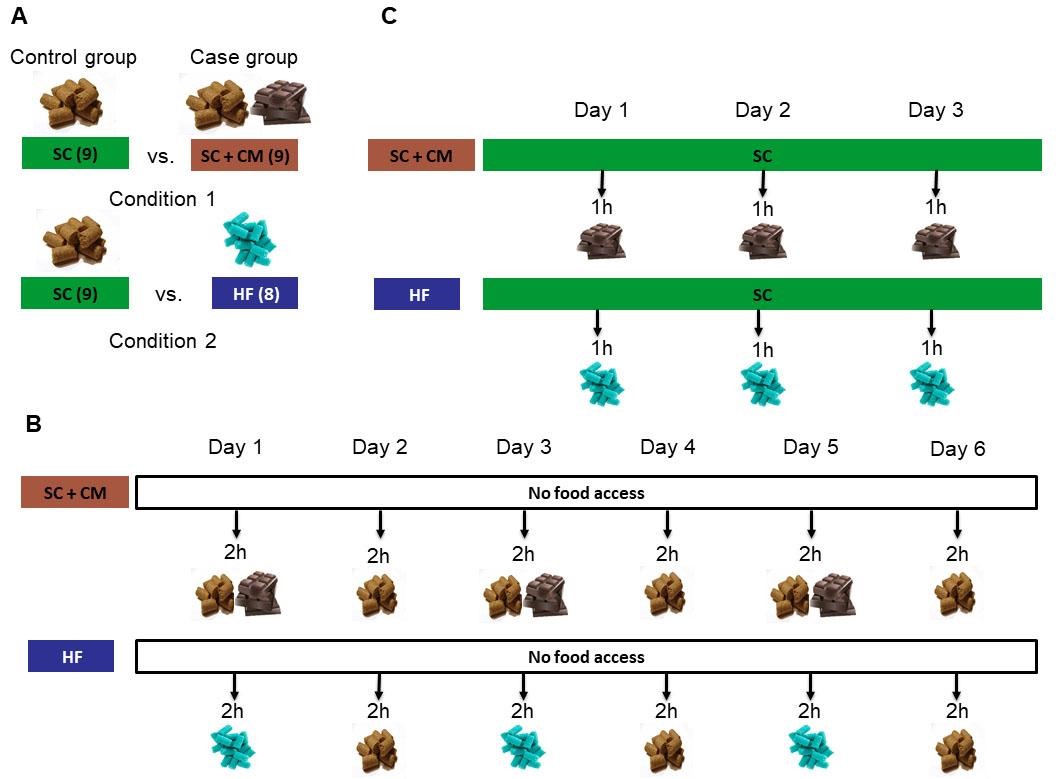
Figure 1. Schematic representation of the main experimental procedures. A. Two different experiments were carried out each of them with a separate control group, namely condition 1 and condition 2. Control group in both conditions 1 and 2 received standard chow (SC) ad libitum. After the habituation period, in condition 1 case group was provided with a free-choice between a standard chow diet and a chocolate-mixture diet (CM), while in condition 2 case group was offered only a high-fat (HF) hypercaloric food. Sample size is shown in parentheses denoting the number of mice in each group. B. Timeline of the limited access to energy-dense foods test in condition 1 (above) and condition 2 (below). Overweight mice were offered CM (condition 1) or HF (condition 2) pellets a single hour during the light (resting) phase of the light-dark cycle for 3 consecutive days to measure feeding inflexibility. C. Representation of the setup used to evaluate compulsive-intake in diet-induced obese mice of condition 1 (above) and obese mice of condition 2 (below). Mice have restricted the access to food to 2 h per day at the beginning of the dark phase during 6 consecutive days. On Days 1, 3 and 5 control mice received standard chow, while case mice in condition 1 are given standard chow/chocolate mixture and case mice in condition 2 are presented with high-fat diet. On Days 2, 4 and 6 all animals received only standard chow.- Standard chow (SDS, Witham, UK, catalog number: 801151)
Standard chow contained 10.76 MJ kg-1 digestible energy (17.5% coming from protein, 75% from carbohydrate and 7.4% from fat; Table 1). Typically, standard chow carbohydrates are contributed to by 45% starch and approximately 4% simple sugars (monosaccharide plus disaccharides) as a proportion of total carbohydrates by weight. - Pellets of a mixture of commercial chocolates (CM)
CM are made from equal amounts of Bounty®, Snickers®, Mars® and Milka® chocolates (local supermarket). CM pellets contained 20.6 MJ kg-1 digestible energy (17% coming from protein, 52% from carbohydrate and 24% from fat; carbohydrate is contributed to by 8% starch and approximately 44% simple sugars (monosaccharide plus disaccharides, Table 1). - High-Fat (HF) diet (Test Diet®, catalog number: 58Y1)
HF consisted of commercial pellets of purified diet with 60% energy derived from fat. HF pellets contained 22 MJ kg-1 digestible energy (24% coming from protein, 30% from carbohydrate and 35% from fat; carbohydrate is contributed to by 5.4% starch and approximately 6.4% simple sugars (monosaccharide plus disaccharides, Table 1).
- Diets listed above describe what has been used successfully using the protocol provided; however, using alternative diets with similar composition could also be successful.
- Food was renewed every 3-4 days to ensure the maintenance of the organoleptic properties. We have consistently observed in several of our experiments that around 15% of mice under a high-energy free choice obesogenic diet do not gain weight (obese-resistant).
Table 1. Nutritional composition and energy content of the experimental diets. The composition of the SC and HF diets was provided by the manufacturers. CM diet was prepared in the lab and its composition was analyzed by Alquimisa laboratories S.L (Salamanca, Spain).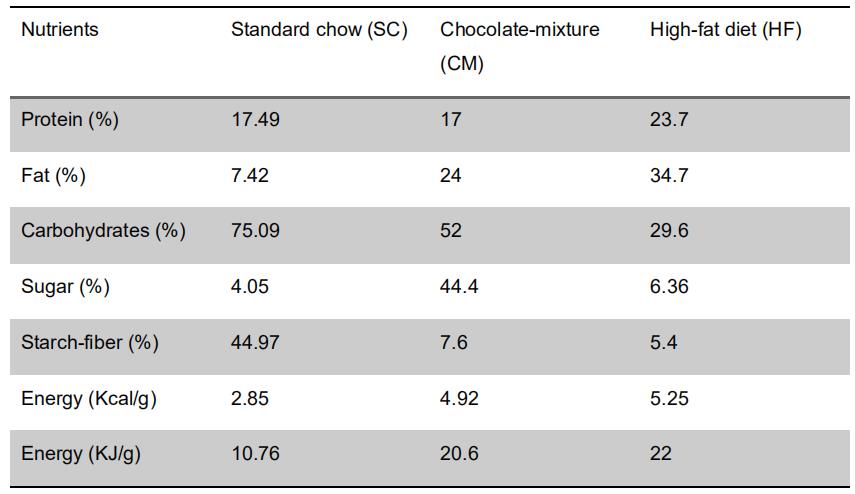
- Standard chow (SDS, Witham, UK, catalog number: 801151)
- Quinine hydrochloride dehydrated (Sigma-Aldrich, Madrid, Spain, catalog number: Q1125) for the adulteration of food in order to test mice feeding inflexibility.
Equipment
- Grinder and spoon for chocolate mixture (Bounty®, Snickers®, Mars® and Milka®) pellet preparation
- Diet storage refrigerator
- Personal computer for data recording using RS232/USB port
- PheCOMP System (Multitake model, Panlab, Barcelona, Spain, catalog number: LE0851B)
The equipment consists of experimental cages (Mouse polycarbonate home cages; Allentown Caging Equipment, ACE, 197 weight x 306 depth x 212 height mm, see Bura et al., 2010) provided with a grid floor and a filter top. The platform supporting each cage contains 2 infrared frames (16 x 16 beams, 16 mm spaced) allowing simultaneous recordings of horizontal activity and rearing (Panlab LE8827 Rearing IR frame).
Notes:- The cages contain 2 feeder units and 2 drinking units and give intake data resolutions of 0.02 grams per second allowing higher precision of the amount of food (g) or liquid consumed (ml) compared to standard cages; see Figure 2. The quantity of water drunk from a nipple, and any possible dripping, are also accounted by using the same system of transducers with 20-μl precision. The modular structure allows multiple dispenser combinations made them suitable for our free-choice experiments.
- One cage can only be used for one mouse.
- Before each experiment, the weight transducer system of the cages are calibrated. To do so, the manufacturer (Panlab, Barcelona, Spain) provides a 20 grams precision weight that is used to calibrate both the drinkers and feeders.
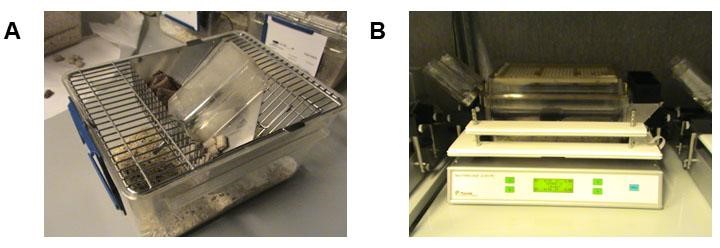
Figure 2. Representative images for housing cages used during the study. A. Standard individualized cage for mouse housing. B. A PheCOMP cage (Panlab, Spain), the equipment used to automatically record the food/water intake and activity of individualized mice.
Software
- Compulse software (Panlab, Barcelona, Spain) for automated data collection
- GraphPad PRISM 6.0 software (GraphPad Software. Inc., San Diego, CA, USA), a software for graphing
- SPSS 17.0 (SPSS Inc, Chicago, IL, USA) statistical analysis software
- “mtb2int.pl” and “int2combo.pl” Perl scripts for processing Phecomp cages output files into intervals comma-separated values (CSV) files. The scripts are available on github at: https://github.com/cbcrg/phecomp/blob/master/lib/perl/
- Pergola (Espinosa-Carrasco et al., 2018b) (https://github.com/cbcrg/pergola): Pergola is a Python library and command line tool for the conversion of longitudinal behavioral data into genomic file formats for its analysis and visualization
- Integrative Genomics Viewer (IGV) (Robinson et al., 2011), (http://software.broadinstitute.org/software/igv/), a desktop application for the visualization of genomic data
- Pergola web-server (Espinosa-Carrasco, 2019) (http://pergola.crg.eu/), a user-friendly web interface to process and visualize longitudinal behavioral data using Pergola
Procedure
文章信息
版权信息
© 2019 The Authors; exclusive licensee Bio-protocol LLC.
如何引用
Fructuoso, M., Espinosa-Carrasco, J., Erb, I., Notredame, C. and Dierssen, M. (2019). Protocol for Measuring Compulsive-like Feeding Behavior in Mice. Bio-protocol 9(14): e3308. DOI: 10.21769/BioProtoc.3308.
分类
神经科学 > 行为神经科学 > 实验动物模型
您对这篇实验方法有问题吗?
在此处发布您的问题,我们将邀请本文作者来回答。同时,我们会将您的问题发布到Bio-protocol Exchange,以便寻求社区成员的帮助。
Share
Bluesky
X
Copy link


